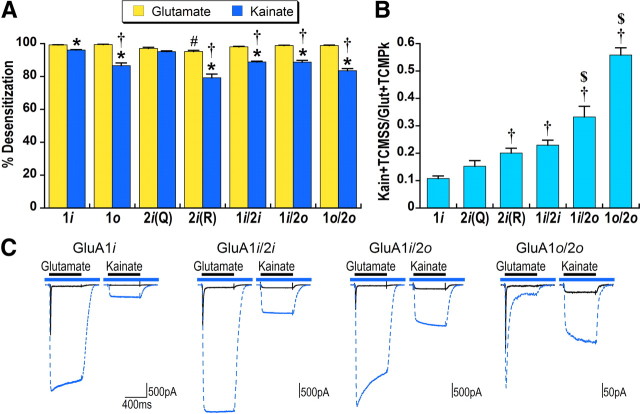Figure 1.
Kainate efficacy and desensitization are affected by receptor composition. A, Percentage steady-state desensitization for saturating concentrations of glutamate (3 mm) and kainate (600 μm) was calculated relative to the peak response with desensitization blocked by 500 μm TCM for homomeric GluA1flip (1i), GluA1flop (1o), GluA2flip(Q), or GluA2flip(R) and heteromeric GluA1flip/2flip, GluA1flip/2flop, or GluA1flop/2flop. Error bars in this and subsequent figures indicate SEM. Significance for this and all subsequent figures was determined using one-way or two-way ANOVA followed by SNK post hoc comparisons. For two-way ANOVA with significant main effects and a significant interaction, subsequent one-way ANOVA followed by SNK post hoc comparisons were used to determine the nature of the interaction (to control for experiment-wise error, only results with p < 0.01 were considered significantly different for these post hoc comparisons). *Significant difference between kainate and glutamate desensitization within receptor type, p < 0.05. #Significance between different receptor composition for glutamate desensitization relative to GluA1flip, p < 0.01. †Significance between different receptor composition for kainate desensitization relative to GluA1flip, p < 0.01. B, Kainate efficacy was calculated relative to peak glutamate responses with desensitization for both agonists blocked by TCM. †Significant difference relative to GluA1flip, p < 0.05. $Significant difference from GluA1flip/2flip, p < 0.05. Each bar in A and B is the mean of data from six to nine cells. C, Representative responses to glutamate and kainate in the absence (solid black line) and presence (dashed blue line) of TCM are overlaid. The blue bar indicates application of TCM and black bar agonist application.

